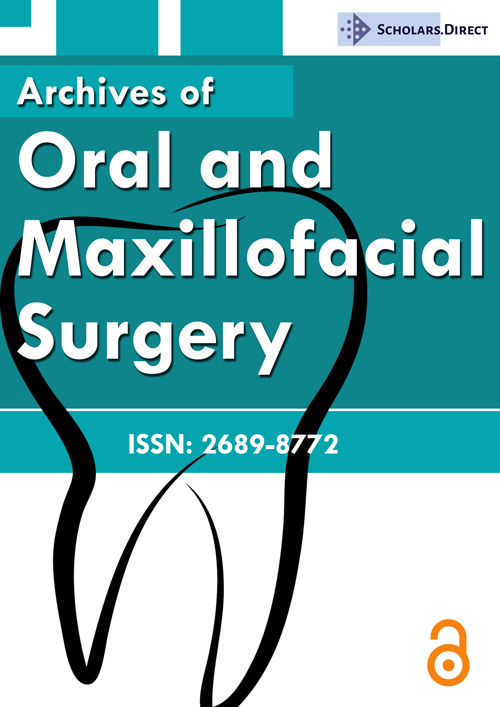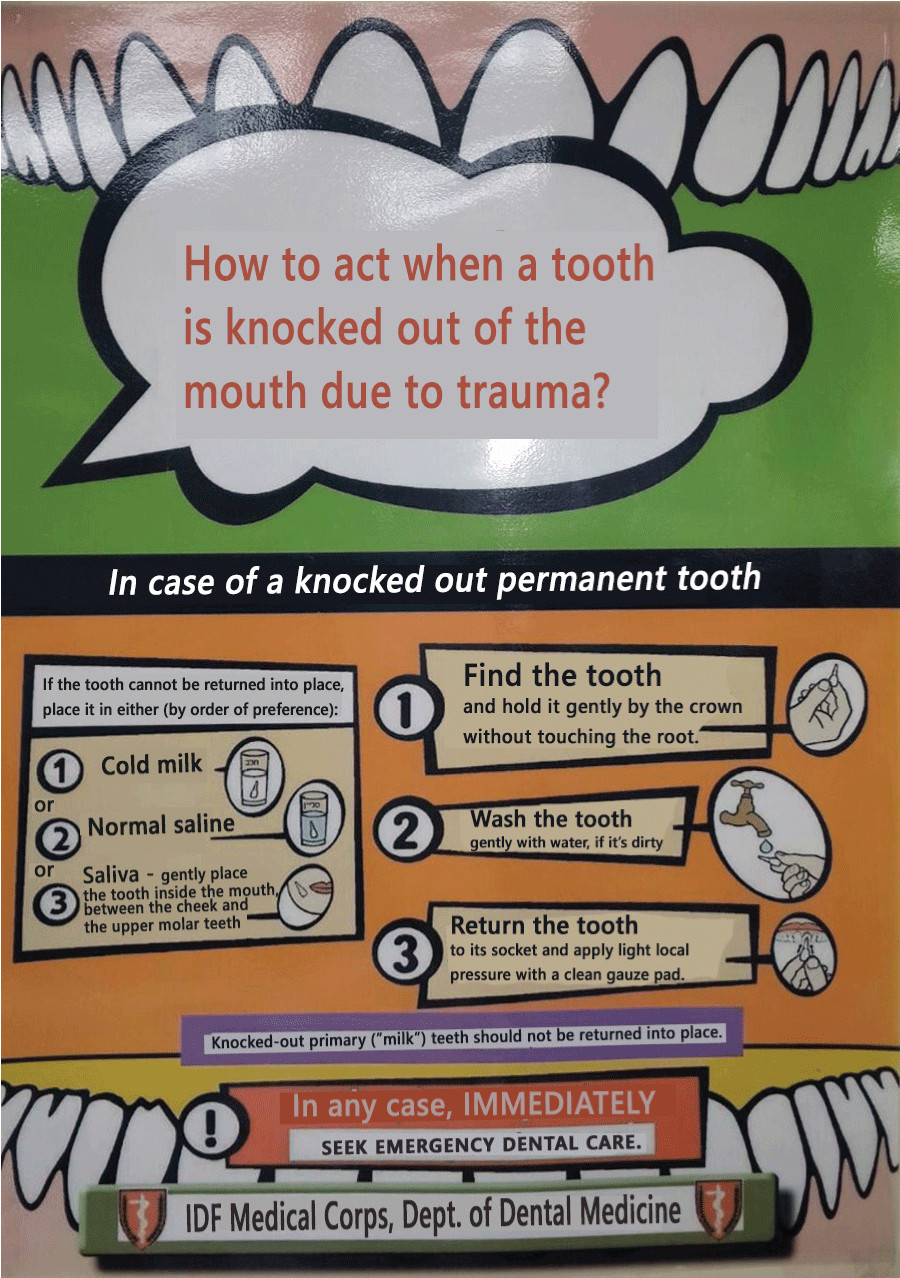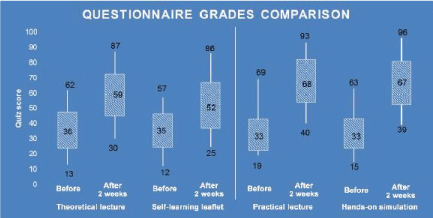Improving Competence in Dental Avulsion Management among Military First-Aid Providers
Abstract
Background and aims
Dental traumas consist 2-8% of all trauma related emergencies in Israeli Defense Forces (IDF); and information on dental trauma is currently provided as part of the medics' basic training. Nevertheless, the combat medics' knowledge in providing first aid and preservation of avulsed teeth is usually insufficient. A lecture and a leaflet on dental trauma are currently provided as part of the medics' basic training. We aimed at improving the didactic means used to teach IDF combat medics during their training, by introducing a focused lecture and a hands-on simulation of dental avulsion management.
Materials and methods
The study was approved by the IDF's Institutional Review Board (IRB). 150 female recruits of similar socioeconomic backgrounds, participating in a basic military medics' course, were divided into 4 cohorts - each receiving instruction of dental avulsion management in one of 4 modalities: An approved lecture, a leaflet, a focused practical lecture and a hands-on simulation. Questionnaires were answered before the intervention and two weeks later.
Results and conclusion
No significant differences in the pre-training grades between the four groups were identified. A significant improvement in the participants' knowledge following a focused, practical lecture and a hands-on training was demonstrated - without significant differences between the two; and a significantly lower improvement following the theoretical lecture and the self-learning leaflet. The authors recommend approaching the subject of dental trauma in a focused, practical and concise manner, as part of the training of medical providers to ensure proper response in dental emergencies.
Keywords
Dental trauma, Education, Avulsion, Lecture, First aid provider
Introduction
Dental avulsion-a complete displacement of a tooth from its socket-is a severe, though relatively uncommon, type of dental trauma. As it occurs mainly between the ages of 7-14, [1,2] it may involve both deciduous and permanent teeth.
The current emergency treatment strategies for avulsed permanent teeth include preservation and hydration of the root surface-as maintaining the vitality of root surface cells is a key factor for replantation success and periodontal ligament healing; and actual replantation within a short time frame. Immediate replantation (within 5 minutes) may result with a favorable clinical outcome. While pulp necrosis will be inevitable, the periodontal ligament may still survive and heal. If immediate replantation is impossible, the time window allowing the best survival chances may be extended for an hour post-avulsion, if the avulsed tooth is stored in a proper medium: Hank's balanced salt solution (marketed in the US under the brand name Save-a-Tooth TM), milk or saliva (or even inside the mouth). Another option is to place the tooth in an ice container. Thus, the first aid provider's knowledge is crucial for the survival of the tooth [2].
Several international efforts to improve the knowledge of first-aid providers and even dental professionals in successfully dealing with avulsed teeth have previously been attempted. Andersson, et al. has established a set of clear and easily comprehensible guidelines, which were also published as a poster and translated to numerous languages [3]. In 2008, Al-Asfour, et al. have demonstrated that a leaflet given to Kuwaiti parents has significantly increased their overall understanding of dental avulsion and its treatment, as assessed one week later. However, guidelines published in writing have only a limited effect in conveying the knowledge to non-professional target populations-and even the authors have noted that the long-term influence of the leaflet remains unknown [4].
The military population is prone to dental trauma due to extensive physical activity and the use of heavy-duty appliances. In 2008, Zadik has stated that dental traumas consist 2-8% of all military dental emergencies, and suggested a protocol for management of such trauma for the use of military corpsmen and medics, whose knowledge of the subject is usually insufficient. The IDF Medical Corps adopted the protocol, which is still in use today-its basic guidelines are conveyed to the medical personnel in a dedicated lecture, given as part of their training; in leaflets delivered following the lecture; and in posters spread through IDF dental clinics [5]. A study performed by Levin, et al. in 2010 has shown a significant increase of knowledge among army recruits immediately after an hour-long lecture on dental trauma [6], yet no further research was done to assess the longer-term knowledge of the subject. In addition, no study has so far compared the contribution of such oral lectures vs. other teaching methods, nor was the contribution of hands-on training of tooth replantation been evaluated.
Our goal was to examine and demonstrate possible differences in the knowledge gained regarding emergency care of dental avulsions by the various means of instruction performed as part of the medics' training in the IDF.
Materials and Methods
A sample of 150 female recruits aged 18-20, participating in a basic military medics' course at the IDF School of Military Medicine were chosen to participate in the study and randomly divided into four groups (Table 1). Each group answered a short questionnaire developed by Andersson, et al. [7] and adapted to Hebrew by Levin, et al. [6], consisting of 29 questions (free text, multiple-choice and true-false), examining prior experience of dental avulsion, general knowledge on dental avulsion and replantation, avulsed tooth preservation methods, time and suitable media. The quizzes were graded according to a key developed by the authors (Table 2), and the results, correct answers or grades were not disclosed to the participants.
Following the quiz, instruction on dental avulsion was given to all four groups in the following manner:
• Group 1- Current, approved lecture on dental trauma and avulsion (1-hour long).
• Group 2- The IDF Medical Corps approved written leaflet (Figure 1).
• Group 3- A focused, practical and illustrated 20-minute lecture focusing on practical steps of dental avulsion emergency treatment. Based on the IADT guidelines [3].
• Group 4- A 30-minute oral instruction (without slides) followed by group hands-on training with a phantom jaw on how to reimplant and avulsed tooth.
Two weeks after this instruction, the participants in all four groups were asked to repeatedly answer the same quiz. The quizzes were graded again in the same manner, and results were recorded and analyzed. ANOVA was used to compare the initial averages of all four groups, Levene and Tukey statistical analyses were applied to compare the group average performance in the final quizzes. The study was approved by the IDF Institutional Review Board.
Results
The initial average grade of all 150 participants was 34.51 ± 10.72 (on a 100-point scale), and no statistical significance was demonstrated between the initial average grades of all four groups prior to the instruction. A statistically significant improvement in the average grades was achieved with all four methods of instruction (Table 3 and Figure 2).
Group 3, receiving a focused, practical lecture (67.94 ± 13.93) and group 4, the hands-on training (66.58 ± 14.16) achieved the highest mean score after the instruction. No significant difference was demonstrated between these two groups. In comparison, the groups receiving the current approved lecture, group 1, and the leaflet, group 2, achieved significantly lower grades 58.79 ± 13.68 and 51.84 ± 14.89 respectively.
With regard to particular questions, the practical lecture and hands-on training group achieved significantly higher scores than the other groups (P = 0.000, CI 95%) when asked about the optimal period of time for replantation of avulsed teeth (78% and 74%, respectively), and avulsed tooth preservation (69% and 74%, respectively). No statistically significant differences were seen between these two groups.
Another analysis was made to assess the influence of previous personal experience on the knowledge of dental avulsion management. Some participants (34, 22.67%) have answered that they experienced dental trauma in the past, however no significant difference was found between the experienced (M = 34.1765, SD = 8.22587) to the unexperienced (M = 34.6121, SD = 11.37638) with regards to their initial exam score (t (148) = 0.208, p = 0.836).
Discussion
Dental trauma is quite a common experience among children and young adults. In 2008, Zadik, et al. have demonstrated that 29.76% of 18-year-old young males have experienced various kinds of dental trauma in the past. Among the young females participating in our study, however, the rate was lower 22.67% - perhaps due to gender differences in trauma experience. A recent report has demonstrated a male-to-female ratio of 1.8:1 in childhood dental avulsion and luxation cases [8].
Nevertheless, previous experience of dental trauma had no significant effect on our participants' knowledge of the subject. The finding is consistent with a study performed among Malaysian rugby players that has, curiously enough, demonstrated that players who have previously experienced dental trauma may actually not seek emergency care unless they feel pain [9].
As emergency treatment of dental trauma should be provided as soon as possible, in order to increase the chances of survival of the avulsed teeth, combat medics and first aid providers should be taught a clear emergency protocol as part of their basic training, ensuring a proper and rapid response and allowing knocked-out teeth a chance for survival. Previous studies have proven leaflets, posters and theoretical materials useful, and significantly improving short-term knowledge of the populations approached-both lay people and medical caregivers [4,6,10,11]. However, our study demonstrates that knowledge acquisition by these means is less effective. Leaflets are seldom read thoroughly, if at all, and a single theoretical lecture given as part of a lengthy course is destined to be forgotten. In a study performed among Norwegian pediatric dentists, about two-thirds of the dentists answered correctly, yet only 21% have assessed their own competence in avulsion treatment as "sufficient" [12]. Thus, even dental and medical professionals tend to demonstrate rather limited competence in treatment of dental trauma [13], and if the mighty have succumbed, how can the weak-the lay people in our case - emerge unscathed?
In our study, we have demonstrated the importance of using a practical and focused clinical lecture, combined with elements of hands-on training, to further deepen the understanding of the subject and ensure proper response in dental emergency situations. Although the recent availability of smart phone apps with trauma management instructions may open new possibilities for online search reference and even render memorizing protocols useless in civilian environment [14], in military settings a cell phone with data connection may not be readily available, and nothing would replace thorough knowledge and fast response of a first-aid provider.
In the conclusions of his review article, Glendor [13] suggested that dentists should be regularly educated on the emergency treatment of dental trauma. The authors embrace this recommendation, along with proposing to expand it to all first-aid providers. However, the kind of instruction given matters greatly-and our study has shown that first-aid could be effectively taught to deal with dental trauma, using a practical and focused clinical lecture with elements of a hands-on simulation. A clear, concise and focused lecture, illustrated by memorable photographs or video, followed by demonstration of tooth repositioning and practical hands-on training, may be a key to the improvement of long-term knowledge retention, and eventually to the successful retention of more avulsed teeth. However, previous research has shown that long-term retention of the knowledge tends to decline even among dentists [13] and dental students [15]. Moreover, our study dealt with rather homogenous population-young girls qualified to participate in a military medical course. It is possible that similar research performed among other populations (males, adults or representatives of less-educated strata of society) could yield different results. Thus, additional research is required to determine the long-term practical knowledge decline by combat medics and means of its preservation.
Conflict of Interest Statement
The authors whose names are listed above certify that they have NO affiliations with or involvement in any organization or entity with any financial interest (such as honoraria; educational grants; participation in speakers' bureaus; membership, employment, consultancies, stock ownership, or other equity interest; and expert testimony or patent licensing arrangements), or non-financial interest (such as personal or professional relationships, affiliations, knowledge or beliefs) in the subject matter or materials discussed in this manuscript.
References
- Holan G, Needleman HL (2014) Premature loss of primary anterior teeth due to trauma-potential short- and long-term sequelae. Dent Traumatol 30: 100-106.
- Trope M (2011) Avulsion of permanent teeth: Theory to practice. Dent Traumatol 27: 281-294.
- Andersson L, Andreasen JO, Day P, et al. (2012) International Association of Dental Traumatology guidelines for the management of traumatic dental injuries: 2. Avulsion of permanent teeth. Dent Traumatol 28: 88-96.
- Al-Asfour A, Andersson L (2008) The effect of a leaflet given to parents for first aid measures after tooth avulsion. Dent Traumatol 24: 515-521.
- Zadik Y (2008) Algorithm of first-aid management of dental trauma for medics and corpsmen. Dent Traumatol 24: 698-701.
- Levin L, Jeffet U, Zadik Y, et al. (2010) The effect of short dental trauma lecture on knowledge of high-risk population: an intervention study of 336 young adults. Dent Traumatol 26: 86-89.
- Andersson L, Al-Asfour A, Al-Jame Q, et al. (2006) Knowledge of first aid measures of avulsion and replantation of teeth: An interview study of 221 Kuwaiti school children. Dent Traumatol 22: 57-65.
- Cho SY (2015) Dental luxation and avulsion injuries in Hong Kong primary school children. Hong Kong Med J 21: 339-344.
- Abdullah D, Liew AK, Wan Noorina WA, et al. (2015) Association of dental trauma experience and first-aid knowledge among rugby players in Malaysia. Dent Traumatol 31: 403-408.
- Ghaderi F, Adl A, Ranjbar Z, et al. (2013) Effect of a leaflet given to parents on knowledge of tooth avulsion. Eur J Paediatr Dent 14: 13-16.
- Cecilia Young, Kin Yau Wong, Lim K Cheung, et al. (2013) Effectiveness of educational poster on knowledge of emergency management of dental trauma-part 1. Cluster randomised controlled trial for primary and secondary school teachers. PLoS One 8: e74833.
- Skaare AB, Pawlowski AA, Maseng Aas AL, et al. (2015) Dentists' self-estimation of their competence to treat avulsion and root fracture injuries. Dent Traumatol 31: 368-373.
- Glendor U (2009) Has the education of professional caregivers and lay people in dental trauma care failed? Dent Traumatol 25: 12-18.
- Djemal S, Singh P (2015) Smartphones and dental trauma: The current availability of apps for managing traumatic dental injuries. Dent Traumatol 32: 52-57.
- AlZoubi F, Mannocci F, Newton T, et al. (2015) What do dental students know about trauma? Dent Traumatol 31: 482-486.
Corresponding Author
Dimitry Fiterman, Academic staff, Jerusalem College of Technology, Havaad Haleumi 21 St., Amishav st. 30/4Tel Aviv, 6719128, Israel, Tel: +972-55-6672386.
Copyright
© 2017 Dvoyris V, et al. This is an open-access article distributed under the terms of the Creative Commons Attribution License, which permits unrestricted use, distribution, and reproduction in any medium, provided the original author and source are credited.






